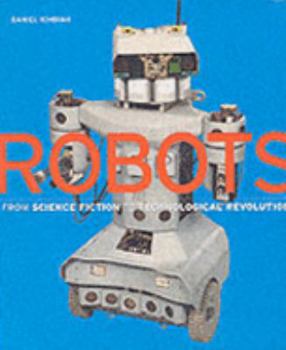Robots: From Science Fiction to Technological Revolution
A visual survey of the scientific developments and cultural significance of robots documents the history of automatons, androids, and other forms of artificial intelligence, both of the fictional and... This description may be from another edition of this product.
Format:Hardcover
Language:English
ISBN:0810959062
ISBN13:9780810959064
Release Date:May 2005
Publisher:Harry N. Abrams
Length:540 Pages
Weight:4.10 lbs.
Dimensions:1.5" x 7.8" x 9.3"
Age Range:13 years and up
Grade Range:Grade 8 to Postsecondary
Customer Reviews
2 ratings
Past & Future Robot Experiments.
Published by Thriftbooks.com User , 19 years ago
Man's quest to replicate living beings goes back thousands of years. Today, there is a 21st century robot with a mobile body complete with intricate computer software, making it "act" rationally. The "thinking android" of our century has evolved through many stages. For years, we've seen robots in movies, science fiction, and on television. I loved R2D2 and C3PO in the first 'Stars Wars' feature. Robots don't ever have feelings. They do what they are programmed for and nothing else. Only twice, in the movies, have any robots neared human emotions, the "star" of R.O.B.O.T.S and the 'dear family robot' in the movie, 'Centennial Man' played by Robin Williams. The clones in the movie, 'The Island,' were programmed to be robots, but some actually became human with needs and feelings of man. The Planetary Society's second attempt to place a solar sail into Earth orbit failed when the Volna boostre's first stage misfired shortly after launch from a submarine in the Barents Sea. In a previous attempt in 2001, the Cosmos 1 solar sail did not separate from the booster's third stage. The Society had hoped to make the first controlled flight of a solar sail, which is probelled by only the faint pressure of photons on its eight reflective triangular blades. Such vehicles, a type of robot, are predicted to eventually achieve speeds five times as great as those achieved by a chemical-powered rocket. In Lille, France, the European Capital of Culture, is a 'fetus to man' sculpture. It has a life-sized metal clock-jack. The human figure, or jack, are the hands on the clock; fetus in the womb at 6:00, erect as an adult at 12:00, old age at 6:00 as he bends under the weight of the years. A fantastic thing to see. The photos in this book are "out of this world." Back in 1993, my year of temp. jobs on computers, I kept promoting my ability to work 'robotics.' The only talking robot I'd ever seen in person was at Knoxville's 1982 World's Fair, so I know very little about them. And yet, I constantly spoke of being able to control robots, thinking I could get a better job. In our small town and the lawnmower/bicycle factory where I had my last job, robotics were primitive and the operator punched a few buttons for them to perform the more intricate jobs the Japanese do by hand. We're not that technical in America so most every job was done by hand. I was 'accurate but not fast' at data entry and our boss from Memphis, Steve (whose ancestor was an infamous criminal in the Old West), assured me that my accuracy was more important than the enormous errors made by the faster temp staff. He said, when the job was completed, "When iI return, I expect Betty to own a robot factory." Actually, he was back in a few months and said he was glad that I was the one sent to help his crew organize a new computer accounting system for that same factory, Gabriel. I heard him telling others that he was going to hire a full-time person, but he didn't get around t
An encyclopedia work on robotics for the new century
Published by Thriftbooks.com User , 19 years ago
Since the first industrial robot was introduced less than 50 years ago, robot development has progressed in significant pace. Hence, robots are gradualy populated in different aspect of our everyday life in recent years. This book provides a comprehensive introduction of the history of robot development, current state-of-the-art, and a glimpse into the future of robots. The entire book is divided into 12 major sections covering: robot history, robots in fiction (TV, movies, literatures, etc), humanoid robots, domestic service robots, industrial robots, exploratory robots, security robots, medical robotics, toy robots, robotic arts, future directions of robot development, and a practical reference guide for robot enthusiasts. For each topic, the author provides many example systems with heavy illustrations and very readable text. In between the description of different robotic systems, the author also provides interviews of roboticists in the sideboxes. Most importantly, the content is up-to-date till 2004. People from different level of background in robotics will all find the book useful and enjoyable to read.






